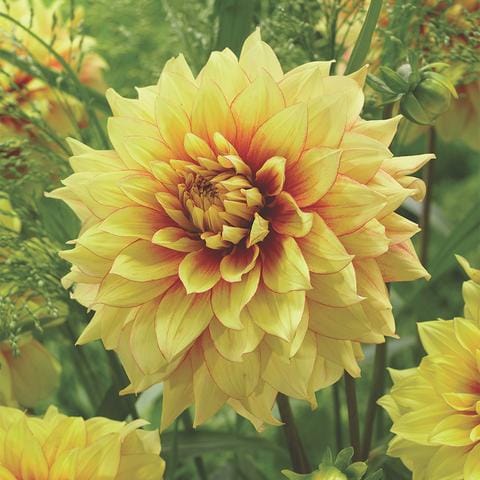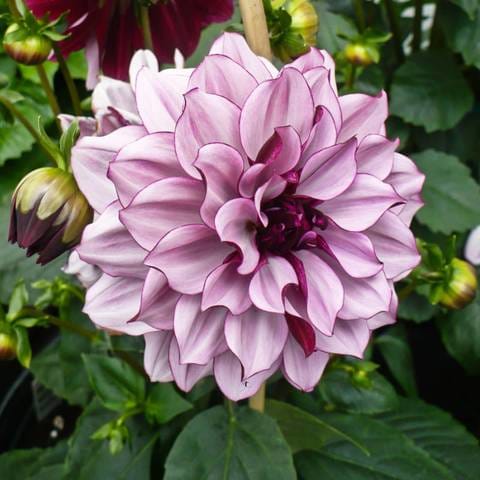Ah, the show stopping, spotlight-stealing dahlia. These gorgeous blooms are so pretty and profuse that they have earned an unfair reputation as high-maintenance and hard-to-grow. Nothing could be further from the truth! Whether you grow them from seeds or tubers, dahlias are so simple to start, tend, and shelter over the winter.
Dahlias might just be the world’s best cutting flower. How many other flowers can create the drama and impact of a full bouquet from just a couple of stems? Each dahlia blossom is a pyrotechnic pinwheel of petals, a spectacular starburst of color. And they are prolific bloomers, too! Once established, dahlias bloom for months without any fuss or bother.
We’re obsessed. And we know you are, too! While Pinetree Garden Seeds has long sold a spectacular array of dahlia seeds, including individual AAS winners and brilliant mixes, we are so excited to be adding fresh tubers to our dahlia offerings in 2021 at our customers’ request. Before we start shipping our latest dahlia offering, we thought we would share a few tips and tricks to getting the most out of these gardening glories!
STARTING DAHLIAS FROM TUBERS
The easiest way to start dahlias is to sprout tubers in late spring that were gathered the previous fall. Pinetree Garden Seeds will start shipping dahlia tubers in mid to late March, in time for spring planting. So, what should you do when your tubers arrive?
If your soil has reached 60 degrees F, you can sow your tubers outdoors in your backyard garden about 18” to 2’ apart. If your soil is not yet that warm, you will want to start your tubers indoors in pots. Make sure the stem or sprout is facing up and cover your tuber with 2” of rich soil and plant out when conditions improve.
STARTING DAHLIAS FROM SEEDS
Starting dahlias from seeds is no trickier than any other seedling. (And you only have to do it once! Taking dahlias up over the winter lets you start next year’s plants from tubers.) They are just a bit slower to germinate than other seeds you might have tried in the past—up to 21 days for some varieties. So don’t give up hope! They will be coming up in good time.
Dahlia seeds will do best if sown 6-10 weeks before the last frost in a seedling mix then transplanted to a rich potting soil and given steady light. Harden and transplant seedlings after the last frost and give them at least 18” to 24” of space. Most dahlias will grow to about two feet in height.
FOUR TIPS TO HELP YOUR DAHLIAS GROW
-
Dahlias grow best when they receive a regular supply of water. Drip irrigation is the gold standard for dahlias but as long as you supply steady moisture, your dahlias will deliver. Like many plants, dahlias should be watered deeply from below to keep foliage dry and free of mold or blight.
-
Use organic fertilizing and pest control methods. Dahlias are not susceptible to many garden pests, so they respond well to all-natural fertilization and pest prevention techniques. The one exception is snails and slugs, who do love tender young dahlia leaves. If you start seeing signs of a snail or slug attack, clear the ground around the plants of spent leaves and mulch these pests like to hide in and sprinkle the earth with natural slug and snail deterrents.
-
When your dahlias have reached about a foot in height, pinch off the main stem to prompt the plant to put out more profuse growth and flower buds.
-
If you are not cutting all of your dahlia stems, regular dead-heading of spent blooms will keep your dahlias in full flower for longer. You can pop off wilted blooms or you can take the time to prune back the stem, which will encourage longer stems for cutting and more new growth.
If you intend to keep a particular dahlia plant in the garden solely for outdoor decoration, our gardening experts recommend snapping off the buds closest to the main stem. This encourages the plant to put out blooms around the perimeter, where they will be shown to best effect.
PROTECT YOUR DAHLIAS OVER THE WINTER
Regardless of your microclimate, dahlias keep dazzling late into the season, long after most other flowers have gone dormant. As they blaze out of early autumn beds it is time to begin thinking of how you can overwinter these floral wonders after the first killing frost.
In some growing zones 8 to 11, dahlias are considered winter-hardy perennials and you need only cut them back to a few inches above soil level for them to survive and begin regrowing in the spring. If you live in zones 2 through 7, however, your winter temperatures dip below 20 degrees F and your dahlias need more protection to power through to spring.
Taking up dahlia tubers is not a complicated process. This step-by-step guide from the Dahlia University shows you exactly how it should be done—with pictures! Once prepared and wrapped, dahlia tubers can be stored in a cool, dark, and dry place but should not be allowed to freeze. See how easy it is to tuck them in for spring?
Are you excited that Pinetree Garden Seeds is now offering dahlia tubers? Which varieties of dahlias are your personal favorites? Share your stories in the comments, reserve your dahlia seeds or tubers, and get ready for a dazzling dahlia season.





Hi Charles,
That depends on what variety you have! If you’re growing the GoGo type, leave those tubers; they’re meant to be smaller and bushier. If you’re looking for BIG dahlia blooms, you will want to cut back shoots. That’s how you get those “dinner plate” sized flowers.
My tubers are producing multiple shoots, 4 to 5 shoots per plant. Do i need to remove all the shoots but one? Thanks
I live in NJ and I have 3 Dahlia plants in the ground, never dug up for 25 years. They are on the south side my house and i planted them deeply.
I had a 4th and it did not come up 3 years ago. If you have extra tubers it it worth trying one and see if it overwinters outdoors.
I love them.
I love dahlias and was happy to read your advice on caring for them and getting longer stems. This will allow them to better fit into a cut vase. Thank you.
I’ve decided to give dahlias another try this year. I like the ones with big showy flowers.